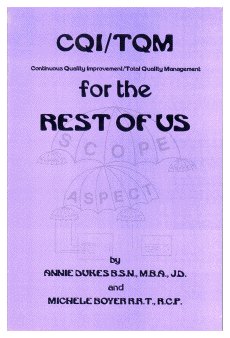CQI/TQM for the Rest of Us
Chapter Topics


CQI/TQM for the Rest of Us
Chapter Topics
What is CQI and TQM?
Continuous Quality Improvement (CQI), also called Total Quality Management (TQM), is a management philosophy that is positively focused, aimed at making good things better, and resolving causes of problems, needs and concerns. It focuses on systems. In so doing, CQI makes you concentrate on the outcome you want and how to achieve it.
To make it easier to view your product from a quality standpoint, start with the premise that the product you sell is service. Even if you produce a material product, that product performs a service to the purchaser. Ultimately, service is what the consumer is buying.
What CQI is NOT
Much of the resistance to CQI/TQM comes from misunderstanding what CQI IS NOT as well as what it IS. We will compare some features and benefits of CQI to previous management philosophies so you can get an idea of just how different CQI is from anything we have seen in the past, and prepare for these common responses to CQI/TQM.
Overcoming Common Objections:
•CQI IS JUST GLORIFIED QA.
•YOU CAN’T CHANGE THE SYSTEM.
•NEGATIVE AFFIRMATIONS THAT
UNDERMINE MOTIVATION.
•I HAVE NO TIME TO DO CQI.
•THIS IS JUST MORE PAPERWORK TO
MEET MORE REGULATIONS.
•WHAT IS WRONG WITH MY WORK?
WE DO A GOOD JOB.
I DO NOT SEE HOW WE CAN
IMPROVE.
•WE WILL HAVE TO SEND PEOPLE TO
EXPENSIVE SEMINARS FOR
TRAINING
CQI IS TOO COMPLEX FOR US TO
DO ON OUR OWN.
The following excerpts from "CQI/TQM for the Rest of Us" gives a peek at what each chapter offers.
Preparing for CQI
Before you begin implementing a CQI program you must establish certain "ground rules" that are essential to a successful CQI program. What is your product in terms of service? Who are your customers? You must appreciate the resources you have in your employees. You must give every concern the benefit of the doubt. You must remain open minded and ready for new suggestions. You never know when an idea that sounds "off-the-wall" in relation to present circumstances might be just the right solution under slightly different circumstances. You must create a non-blaming environment.
Implementing CQI: Getting Organized
Develop a mission statement, a policy and procedure that will establish CQI as your management system, and another one that specifies what each departments responsibilities will be. See examples in Appendix I and II. Once you know who you are, what your product or service is and how you want to make it or provide it, you are ready to begin CQI.
System Assessment Techniques
System assessment techniques allow you to evaluate how your overall business operates. CQI focuses on the way your systems interact with other departments as well as with other systems within our own department to make a smooth running facility. It lends itself to preplanning operations and avoiding crisis management.
CQI Worksheet
YOUR JOURNAL OF PROBLEM, NEED, AND CONCERN RESOLVING ACTIVITIES
The CQI WORKSHEET is central to your CQI program because it is the primary means of communication between your staff. This chapter is the first of two that describe how to DO CQI according to our simple system.
Auditing
To determine how well you are, or are not, doing a procedure you can, do an audit. This will measure the degree of your problem, need, or concern, if any.
This chapter describes how to audit your improvements to ensure that they truly ARE improvements. Audits will help you identify root causes and narrow your corrective efforts so that they focus on just those areas that truly need improvement.
Also Includes
CQI Policies and Procedures
Charts, Tables, and Graphs
© 2008-2014 Ad Hoc Group

To order CQI/TQM for the Rest of Us, please use the form below.
Payment can be made through PayPal or by check. Contact us for payment details.
CQI/TQM for the Rest of Us -
E-Book..................................$ 25.00
92-page e-book is downloadable in PDF format. Includes license to print one copy for purchaser's use.
************************************************
All printouts must include the AHG copyright notice.
************************************************